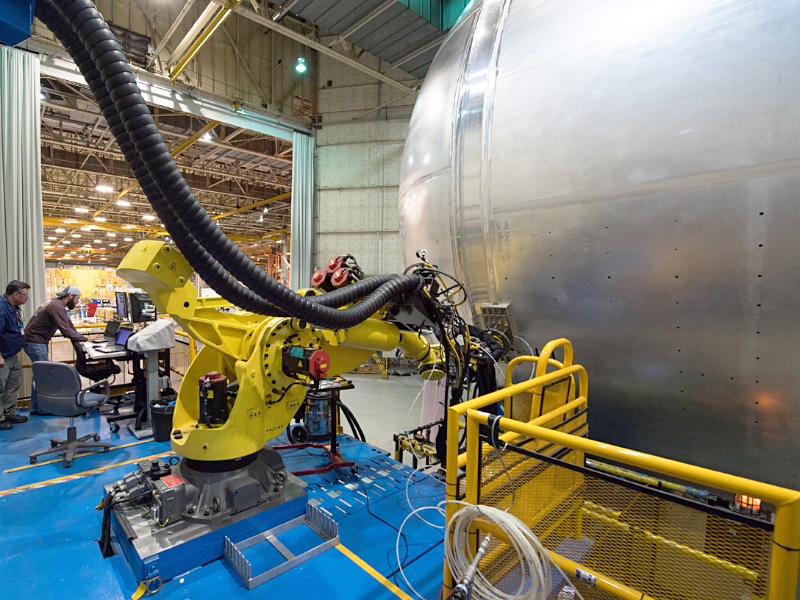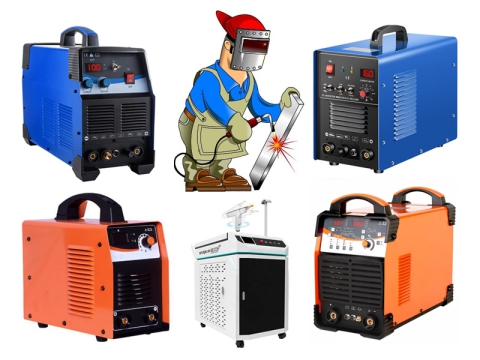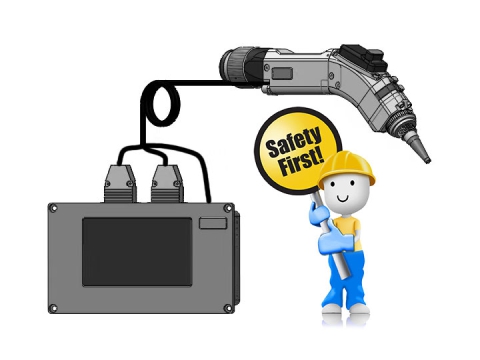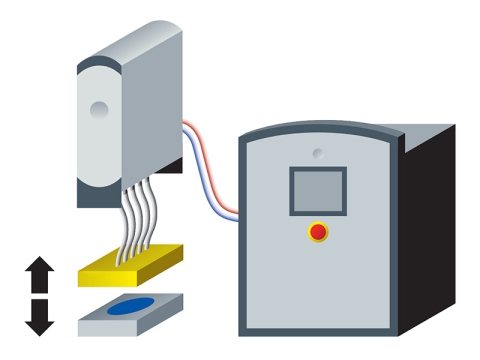3D Robotic Laser Welding Machine in Aerospace Welding
3D robotic laser welding machine is a new type of welding method commonly used at present. The 3D robotic laser welder is configured by 2 parts: a "welding workbench" and a "welding robotic arm". The 3D laser welding robot couples the emitted laser beam into the optical fiber, and then use the parallel beam to focus on the product to perform continuous welding. The continuity of the light in the welding makes the actual effect of welding stronger, and the welding seam is more refined and beautiful.
3D robotic laser welding machine can achieve practical effects such as fast welding speed, small deformation, and no bubbles. At the same time, during the welding process, 3D laser welding robot can adopt non-contact laser welding on the inaccessible parts of the product, which is more flexible and convenient in operation and use; In addition, the welding machine is also equipped with a CCD camera real-time monitoring system, which makes the welding positioning better. Accuracy makes it easy to observe the energy distribution of the welding spot during the welding process, which greatly improves the beauty of the welded product; At the same time, the 3D robotic laser welder can also help enterprises to achieve automation in production, and can also process and produce multiple laser beams at the same time, so as to achieve mass production of products.
Aircraft Welding
The use of welded integral fuselage panels instead of traditional riveted fuselage panels can greatly reduce the w8 of components, reduce manufacturing costs, and improve production efficiency. Therefore, it has become one of the development trends of large-scale civil aircraft manufacturing technology. Because the dual laser beam welding has a more obvious w8 reduction effect on the skin long truss structure, and at the same time, it has better spatial accessibility for complex components, so it has received extensive attention. At present, aerospace manufacturing companies such as Airbus have adopted laser-welded integral fuselage panel manufacturing technology on many of their models. However, welding-based manufacturing technology for integral fuselage panels is a of the difficulties in contemporary civil aircraft manufacturing technology. At present, the new aluminum alloy welding technology for the fuselage panels in the design of large passenger aircraft has its own characteristics in manufacturability.

Laser Welding Robot for Aircraft Welding
Robots are used in various industries due to their high repeatability, good reliability, and strong applicability. At present, the manufacturing process of aerospace products is still labor-intensive, complicated in procedures, and poor working conditions, supplemented by a large number of tooling fixtures and manual manufacturing. The lack of automated production capacity has become a bottleneck restricting the improvement of the reliability and production capacity of weapons and equipment. In the era of vigorously developing aerospace, the application of industrial robots to automated production by aerospace manufacturing enterprises is of great significance to the transformation and upgrading of enterprise production models and the improvement of advanced equipment manufacturing capabilities. Welding is an important link in the formal aerospace product manufacturing process. The role played by welding robots here is extremely important.
Overview of Laser Weldability of Aluminum Alloy
Since the birth of the 1st laser welding machine in 1960, laser welding technology has developed rapidly. In 1965, a ruby laser welding machine for welding thick film components was developed. In 1974, the world's 1st 5-axis laser processing machine, a gantry laser welding machine, was built in Ford Motor Company. Later, Ford Motor Company of the United States developed a laser welding production line. Today, laser generators that can be used for welding have evolved from the 1st generation of CO2 gas lasers to YAG solid-state lasers, as well as the latest fiber lasers. The biggest advantage of laser welding is that its energy is concentrated, resulting in a large aspect ratio of the welded joint and small welding deformation. With the continuous improvement of laser beam quality, laser welding has now become a mature welding method, widely used in different fields of national economy and national defense construction.
Aluminum alloy has low density, good corrosion resistance, high fatigue resistance, high specific strength and specific stiffness, and is an ideal material for aircraft structures. In recent years, although new materials such as titanium alloys and composite materials have received extensive attention in the aerospace industry, due to a series of advantages such as rich resources, excellent performance, easy processing, and low cost of aluminum, and the continuous new heat treatment of traditional aluminum alloys Development and the emergence of new aluminum alloys (such as aluminum-lithium alloys), it is foreseeable that the application of aluminum alloys in aircraft structures will still have irreplaceable advantages for a long period of time in the future. Therefore, aluminum alloy welding technology has become an important technical key. The use of laser welding technology to connect aluminum alloy aviation components has many advantages such as large weld depth-to-width ratio, small welding heat-affected zone, small welding deformation, and high welding speed. However, laser welding of aluminum alloy has some technical difficulties.
A Detailed Description of Laser Welding Scheme for Fuselage Panel of Large Passenger Aircraft
In the laser welding components of the long truss of the skin of the fuselage of the large passenger aircraft, the length of a single weld may be more than 4m. At the same time, since the skin and the long truss are very thin, the stability of the welding process can be effectively maintained by welding production. One of the keys to success. In this solution, dual laser beams are simultaneously welded on both sides of the inner side of the skin. In order to maintain the integrity of the outer skin, the welding process cannot penetrate the skin, and the T-shaped structure does not need to emphasize the aspect ratio too much. The key is to form a continuous, defect-free, high-performance welding joint. Therefore, it is necessary to maintain the stability of the small holes and molten pool during laser deep penetration welding.
It is mainly considered from 2 aspects: On the one hand, from the perspective of welding tooling and equipment guarantee, it is necessary to maintain high-precision clamping and laser focusing and centering, and to maintain a high repetition in the movement of the 3D Robotic laser welding machine to control the welding head. Positioning accuracy and trajectory positioning accuracy, when necessary, use an appropriate tracking system; on the other hand, due to the good fluidity of liquid aluminum alloy, low surface tension, poor stability of the molten pool, at the same time, the ionization energy of aluminum is low, and the welding process is light. Plasma is prone to overheating and expansion, and it also leads to poor welding stability. Therefore, research should be carried out from the perspective of welding metallurgy.
1. Aluminum alloy has a very high initial surface reflectivity for laser beams (over 90% for CO2 lasers and close to 80% for YAG lasers), which requires a larger laser power before the molten pool is formed;
2. Due to the influence of multiple factors such as metallurgy and technology, aluminum alloy laser welding is more prone to pores;
3. Aluminum alloy is a typical eutectic alloy, and it is more prone to hot cracks under laser welding rapid solidification conditions;
4. The laser welding gap adaptability is small, and the assembly accuracy of the weldment is high;
5. Aluminum alloy has a large linear expansion coefficient, which is easy to produce welding deformation;
6. The thermal conductivity of aluminum alloy is large, the cooling time is short, and the metallurgical reaction of the molten pool is insufficient, which is easy to cause defects;
7. Liquid aluminum alloy has good fluidity, low surface tension, and poor stability of the molten pool.
Laser Welding Technology is The Most Effective Methods for Welding Aluminum Alloys in Aerospace Manufacturing
Laser welding technology is still one of the most effective methods for welding aluminum alloys in the aerospace field. With continuous experiments and research, laser welding gradually showed its good process performance and mechanical properties after welding. Compared with traditional TIG welding and MIG welding, laser welding has the characteristics of high welding quality, high precision, and fast speed. It is currently one of the fastest developing and most researched methods. In recent years, many international scientific researchers have carried out a lot of research on aluminum alloy laser welding, and gradually formed a more reliable aluminum alloy laser welding technology.
Compared with traditional riveted fuselage wall panels, laser welding fuselage wall panels have obvious w8 reduction effects, can improve the performance of the connecting parts, and have the advantages of reducing manufacturing costs and improving production efficiency. However, the stress concentration and deformation problems caused by laser welding are not present in the riveting process. The laser welding process of the fuselage panel of a large passenger aircraft is a complex welding process with large size, small thickness and multiple weld seams, and its deformation process is very complicated.
Rocket Welding
The engine is the heart of the rocket, and the harsh working conditions put forward harsh requirements on the structure of the rocket engine. The nozzle body area needs to withstand the impact and strong vibration of the tail flame airflow, and the high-speed jet velocity exceeds 4 Mach. The distance between the inner and outer layers of the nozzle extension section is only 1mm, which is a double sky of ice and fire: low-temperature fuel below -100℃ flows inside the interlayer, and supersonic tail flames over 3000℃ outside the interlayer. The interlayer needs to withstand dozens of Even hundreds of atmospheric pressure shocks and strong vibrations caused by them; a series of stringent requirements pose a huge challenge to the quality of engine welding.

Laser Welding Robot for Rocket Welding
3D robotic laser welding machine has many advantages as a welding method of rocket engine body and nozzle extension. The traditional rocket engine nozzle extension section is divided into: regenerative cooling type, radiation cooling type, exhaust cooling type, ablation cold air type. Vacuum brazing is a conventional welding method for the sandwich of milling groove regenerative cooling nozzles. This method has average weld strength and complicated operation procedures. The welding needs to be carried out in a vacuum environment. It is difficult to automate the welding process and requires relatively high technical level of operators. High, and the manufacturing cycle is long, and the production cost is high. After analysis and demonstration, laser welding is the 1st choice for the welding of the sandwich structure of the milling groove regenerative cooling nozzle. It has many advantages such as short manufacturing cycle, high degree of automation, and low environmental requirements. It can greatly shorten the rocket engine nozzle development cycle (compressible to 10 hours), reduce the manufacturing cost of the nozzle, thereby effectively reducing the rocket launch cost.





